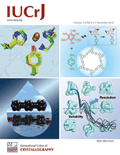
BIOPHYSICAL CHEMISTRY
Scope & Guideline
Elevating academic discourse in biochemistry and biophysics.
Introduction
Aims and Scopes
- Molecular Characterization:
Research often centers on the structural and dynamic characterization of biomolecules, including proteins, nucleic acids, and lipids, using techniques such as NMR spectroscopy, X-ray crystallography, and electron microscopy. - Aggregation and Amyloid Formation:
A significant focus is on understanding the mechanisms of protein aggregation and amyloid formation, which are implicated in various neurodegenerative diseases, including Alzheimer’s and Parkinson’s disease. - Biophysical Interactions:
Studies frequently investigate the biophysical interactions between biomolecules and their environments, including lipid membranes, using molecular dynamics simulations and experimental approaches. - Computational Biophysics:
The use of computational methods, including molecular docking and dynamics simulations, is prevalent for predicting interactions and understanding the energetics of biomolecular processes. - Thermodynamics and Kinetics:
Research often explores the thermodynamic and kinetic aspects of biomolecular interactions and processes, providing insights into stability, folding, and function. - Nanotechnology Applications:
The journal also publishes studies on the application of nanotechnology in biophysics, such as the use of nanoparticles in drug delivery systems and diagnostics.
Trending and Emerging
- Nanoparticle-Biomolecule Interactions:
There is a growing emphasis on understanding the interactions between nanoparticles and biomolecules, driven by applications in drug delivery, diagnostics, and biosensing technologies. - Phase Separation and Liquid-Liquid Phase Separation (LLPS):
Research exploring the phenomenon of phase separation in biological systems, particularly in the context of protein aggregation and cellular organization, has gained traction, reflecting its relevance in cellular physiology and disease. - Protein Misfolding and Amyloidogenesis:
The study of protein misfolding and amyloidogenesis continues to trend upward, with innovative approaches being developed to understand and manipulate these processes, particularly in neurodegenerative diseases. - Structural Dynamics of Membrane Proteins:
There is an increased focus on the structural dynamics of membrane proteins, leveraging advanced techniques like cryo-electron microscopy and solid-state NMR to elucidate their roles in cellular signaling and function. - Integrative Computational Approaches:
The integration of computational approaches with experimental methods is on the rise, allowing for more comprehensive models of biomolecular interactions and dynamics, particularly in the context of complex biological systems. - Therapeutics Targeting Protein Aggregation:
Emerging research is increasingly directed at developing therapeutics that specifically target protein aggregation pathways, reflecting a shift towards more personalized and targeted treatment strategies for amyloid-related diseases.
Declining or Waning
- Traditional Drug Discovery Approaches:
Research articles focusing on classical drug discovery methods have been less prevalent, possibly due to a shift towards more innovative and technology-driven approaches, including computational drug design and nanotechnology. - Basic Enzyme Kinetics Studies:
There appears to be a decrease in the publication of studies centered solely on basic enzyme kinetics, as the field increasingly embraces more complex biochemical pathways and systems biology approaches. - In Vitro Assays Without Structural Insights:
There is a notable reduction in papers that focus solely on in vitro assays without accompanying structural or mechanistic insights, suggesting a trend towards more integrative research that combines experimental and computational techniques. - Single-Molecule Studies:
The focus on single-molecule studies, while still important, has become less prominent compared to ensemble studies that provide broader insights into molecular interactions and dynamics.
Similar Journals

Biophysical Reports
Pioneering Discoveries in Biophysics and BiotechnologyBiophysical Reports is an esteemed peer-reviewed journal published by Elsevier, dedicated to advancing the field of biophysics and related disciplines. Since its inception in 2021, this journal has rapidly gained recognition, achieving a Q1 ranking in Biophysics and Q2 rankings in both Biochemistry categories and Biotechnology as of 2023. The journal serves as a pivotal platform for disseminating innovative research findings and theoretical advancements, catering to a diverse readership that includes researchers, professionals, and students in the life sciences. With an ISSN of 2667-0747, Biophysical Reports aims to bridge the gap between molecular biochemistry and physical sciences, providing critical insights that contribute to the understanding of biomolecular processes. While offering no open-access options, it adheres to rigorous publication standards, ensuring high-quality content that reflects contemporary challenges and breakthroughs in biophysical research. For those engaged in the biosciences, this journal stands as an invaluable resource for exploring the intricacies of molecular interactions and the implications for biotechnology and genetic studies.

JOURNAL OF BIOMOLECULAR NMR
Exploring the forefront of biomolecular NMR research.JOURNAL OF BIOMOLECULAR NMR, published by SPRINGER, is a leading academic journal dedicated to advancing the field of molecular spectroscopy, particularly in the realm of biomolecular studies. With an ISSN of 0925-2738 and an E-ISSN of 1573-5001, the journal has been consistently publishing high-quality research since its inception in 1991, and continues to do so through 2024. The journal maintains an impressive reputation within its category, achieving a Q2 ranking in Biochemistry and a Q1 ranking in Spectroscopy as of 2023, reflecting its commitment to excellence and innovation in scientific research. Notably, it ranks 26th in Scopus for Chemistry - Spectroscopy and 198th for Biochemistry, indicating its significance in the scholarly community. Although it operates under a traditional access model, the journal serves as an essential resource for researchers, professionals, and students interested in the molecular nuances of biomolecules, offering insights that drive advances in biochemistry and related disciplines.

Doklady Biochemistry and Biophysics
Exploring the Intersections of Life's Molecular MechanicsDoklady Biochemistry and Biophysics is a vital resource for the advancement of knowledge in the fields of biochemistry and biophysics, published by MAIK NAUKA/INTERPERIODICA/SPRINGER. Featuring an ISSN of 1607-6729 and an E-ISSN of 1608-3091, this journal plays a critical role in disseminating research findings and fostering scholarly discourse. Despite its recent ranking in the Q4 quartile for biochemistry and biophysics in 2023, it serves as an essential platform for researchers exploring these intertwined disciplines. The journal’s scope encompasses a wide variety of topics, enhancing the understanding of biochemical processes and physical principles in biological systems. With converged years of publication from 2001 to 2024, it stands as a continual source of knowledge for its readers, who include researchers, professionals, and students alike. While the journal currently does not offer open access options, its contributions remain significant within the scholarly community, illustrated by its competitive Scopus rankings across related fields.

PROTEIN JOURNAL
Advancing Knowledge in Protein ChemistryProtein Journal, published by Springer, stands as a significant academic resource in the fields of Analytical Chemistry, Biochemistry, Bioengineering, and Organic Chemistry. Since its inception in 1996, the journal has dedicated itself to the dissemination of high-quality research focused on protein chemistry and its biomedical applications. With an impressive impact reflected in its classification as a Q2 journal in Analytical Chemistry and Q3 in both Biochemistry and Bioengineering as of 2023, it provides an essential platform for researchers and practitioners to share their findings. The journal embraces the open-access model, enhancing accessibility to cutting-edge research. The Protein Journal is crucial for academicians, industry professionals, and students, catering to their need for rigorous scientific discourse and innovative discoveries in protein studies. With an established track record of converging over two decades of knowledge and research, it continues to influence and shape the advancements in this vital area of science.

CRITICAL REVIEWS IN BIOCHEMISTRY AND MOLECULAR BIOLOGY
Illuminating the Complexities of Molecular BiologyWelcome to Critical Reviews in Biochemistry and Molecular Biology, a premier academic journal published by Taylor & Francis Ltd, dedicated to advancing the fields of biochemistry and molecular biology. With an impressive impact factor and a Q1 ranking in both Biochemistry and Molecular Biology for 2023, this journal serves as a vital resource for researchers, professionals, and students eager to engage with cutting-edge reviews and analyses that synthesize the latest developments in these dynamic areas of study. Since its inception in 1972, the journal has maintained a commitment to high-quality scholarship, providing a platform for critical discussions that accelerate the discovery and understanding of biochemical processes and molecular interactions. Although not open access, its robust editorial peer-review process ensures that published articles meet the highest standards of scientific rigor, making it a trusted source for the scientific community. As we continue to converge toward 2024, we invite you to explore the extensive array of topics and findings that have shaped contemporary biochemistry and molecular biology.

BIOCHIMICA ET BIOPHYSICA ACTA-BIOMEMBRANES
Illuminating the Pathways of Biomembrane ResearchBIOCHIMICA ET BIOPHYSICA ACTA-BIOMEMBRANES is a prestigious journal dedicated to advancing the field of biomembrane research, published by Elsevier. With a notable track record since its inception in 1967, this journal operates under the dual ISSN 0005-2736 and E-ISSN 1879-2642, and has firmly established itself within the scientific community by ranking in the top tiers of various disciplines, including Q2 in Biochemistry and Cell Biology, and Q1 in Biophysics as of 2023. Its impressive Scopus rankings further underscore its importance, with a rank of 24 in Biophysics reflecting its strong impact on ongoing research. Although it does not offer open access, the journal provides comprehensive insights and breakthroughs essential for scientists, researchers, and advanced students focused on biophysical and biochemical aspects of membranes. By disseminating pivotal findings, BIOCHIMICA ET BIOPHYSICA ACTA-BIOMEMBRANES contributes significantly to understanding cellular mechanisms, thereby serving as a vital resource for professionals aiming to explore the complexities of biological membranes.

LIPIDS
Bridging disciplines through lipid exploration.LIPIDS is a renowned peer-reviewed journal published by Wiley, dedicated to the field of lipid research, encompassing biochemistry, molecular biology, and organic chemistry. With its roots dating back to 1966 and a commitment to advancing knowledge until 2024, this journal serves as a vital platform for sharing significant findings in lipid biochemistry and its applications in health and disease. Although it currently does not offer Open Access options, it maintains a respectable standing with a Q3 ranking in Biochemistry and Organic Chemistry, and a Q4 ranking in Cell Biology based on the 2023 category quartiles. Additionally, its Scopus rankings reflect a solid position within the organic chemistry and biochemistry subfields. Published from Germany, LIPIDS caters to researchers, professionals, and students eager to explore the roles of lipids in biological processes and innovatory applications in various scientific disciplines.

CHEMISTRY AND PHYSICS OF LIPIDS
Connecting biochemistry and molecular biology through lipids.Chemistry and Physics of Lipids is a prestigious and influential journal dedicated to advancing the understanding of lipid chemistry and biophysics. Published by Elsevier Ireland Ltd, it serves as a vital resource for researchers and professionals in the fields of biochemistry, cell biology, and molecular biology. The journal has a strong standing within the academic community, as reflected in its 2023 Scopus rankings, where it places in the 82nd percentile for organic chemistry and maintains significant positions in various biochemistry subfields. Spanning from 1966 to 2024, it fosters a comprehensive discourse on lipid-related research and innovation. As a renowned publication in the Q2 and Q3 quartiles across several categories, it supports the dissemination of high-quality research aimed at elucidating lipid functions and their implications in health and disease. Researchers and students alike will find this journal invaluable for staying updated with the latest developments and trends in lipid research.

IUCrJ
Elevating Research Standards in Chemistry and PhysicsIUCrJ, published by the International Union of Crystallography, is a leading open-access journal dedicated to advancing knowledge in the fields of Biochemistry, Chemistry, Condensed Matter Physics, and Materials Science. Since its inception in 2014, IUCrJ has quickly established itself as a prestigious platform for high-quality research, achieving a remarkable record as a Q1 journal across its categories in 2023. With an increasing impact in the scientific community, evidenced by impressive Scopus rankings, IUCrJ offers unparalleled access to groundbreaking discoveries and methodologies that contribute to the understanding and application of crystallography in various disciplines. The journal’s commitment to open access ensures that research is readily available to a global audience, fostering collaboration and innovation in the scientific community. IUCrJ is an essential resource for researchers, professionals, and students aiming to stay at the forefront of crystallographic research and its interdisciplinary applications.

PROGRESS IN BIOCHEMISTRY AND BIOPHYSICS
Empowering Researchers with Cutting-edge FindingsPROGRESS IN BIOCHEMISTRY AND BIOPHYSICS, published by the Chinese Academy of Sciences, Institute of Biophysics, serves as a vital platform for advancing the field of biochemistry and biophysics. With a legacy dating from 1996 through 2024, this journal has been instrumental in disseminating critical research findings and innovative methodologies that push the boundaries of our understanding of biochemical processes and biophysical phenomena. Though currently unlisted as Open Access, the journal embodies rigorous peer-reviewed scholarship, positioned in the competitive Q4 quartile for both biochemistry and biophysics categories as per the 2023 metrics. It caters to a diverse audience, including researchers, professionals, and students who are keen to explore foundational and emerging concepts within these dynamic fields. By publishing comprehensive studies and reviews, the journal not only highlights progress but also fosters collaboration and dialogue among scholars worldwide, making it an essential resource for anyone invested in biochemical and biophysical research.